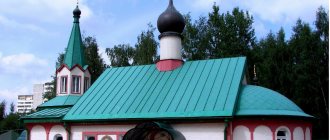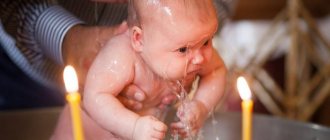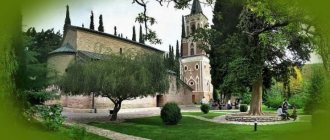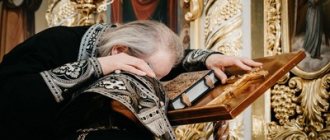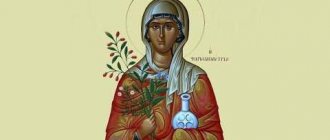The icon of Anastasia the Pattern Maker helps people in the same way that the girl helped her neighbors during her lifetime: she lived during the era of persecution of Christians and spent all her physical and spiritual strength on helping her neighbors. The Lord rewarded her with many gifts, two of which glorified the saint so much that we remember her today.
The name Anastasia means resurrected, risen from the dead. Thus, the holy great martyr foretells us the imminent resurrection in the bodies of all people, and as proof, she helps those praying to her icon today, fulfilling their requests as generously as during her lifetime.
Origin of the saint and childhood
Anastasia was born in the third century after the Nativity of Christ into a wealthy family. Her father was a senator in Rome. He was a convinced pagan, and my mother secretly believed in Christ. She taught her daughter the true faith . She named her daughter in honor of the Glorious Resurrection of Christ (Anastasia is translated as “resurrected”).
The mother found her daughter the best teacher in the city - Chrysogon. He was a Christian and later became a saint. Chrysogon taught the law of God and the Holy Scriptures. Anastasia grew up to be a smart, educated and quite beautiful girl.
Memorial Day and the fate of Anastasia’s relics
In the fourth centuries AD in the West, the saint was revered, and her fame spread widely among the people. This made it possible to build the Church of the Holy Great Martyr Anastasia in Rome itself, taking into account the impatience with Christians that reigned at that time.
The temple was built at the foot of the Palatine, where it still stands today. Roman Popes traditionally serve the so-called “dawn mass” in this church (essentially this is a mass in memory of Anastasia). A prayer for liberation is read by prisoners at Christmas in the hope of helping Anastasia the Pattern Maker
At Christmas, prisoners read a prayer to Anastasia the Pattern Maker for release from captivity.
After the official recognition of the Christian faith as the main one in the Roman Empire, the relics of Saint Anastasia were transferred from Sirmium to Constantinople. And already from modern Istanbul, particles of the saint spread throughout Europe.
Part of the relics of the Pattern Maker was transferred by Emperor Nicephorus the First to Bishop Donatus from the Croatian city of Zadar. Where they were kept in the cathedral dedicated to the saint. There are also arks with remains in Rome, on Mount Athos, in the Bavarian monastery of Benediktbeuern.
Saint Anastasia is one of 7 women included in the traditional Roman canon.
The Great Martyr has her own symbol: a cross and a bottle of oil. The Memorial Day of Anastasia the Pattern Maker is held on January 4 (Orthodoxy) and December 25 (Catholics).
Anastasia's marriage
The girl decided for herself that she would not marry, would remain a virgin, devoting her life to God. But soon her mother left for another world, and the unbelieving father decided his daughter’s fate. He found what he thought was a suitable match for her. Her future groom, Pompilius, was a rich pagan.
Anastasia was unable to avoid marriage with an unloved person. But she managed to preserve her virginity - Anastasia told her husband that she was sick with a contagious disease. Thus, each time she avoided fulfilling her marital duty.
The meaning of the icon Anastasia the Pattern Maker
Reading the life of Saint Anastasia, it is impossible to imagine how a person can endure so much voluntary deprivation and suffering. How a noble Roman woman with a huge inheritance, a kind of heir to an oligarch of the 3rd century, gave away all her wealth and devoted her life to serving those imprisoned, suffering, hungry and sick for the name of Christ. Accordingly, for all the relief of suffering in word and deed, she was nicknamed the Pattern Maker, that is, the one who releases from bonds (from cramped conditions, suffering).
During her lifetime, Anastasia suffered many trials from her husband, from whose marital duty she avoided. The husband was a pagan, and the bride of Christ wanted to maintain a vow of purity and pretended to be sick like a woman in order to avoid intimacy. The husband mercilessly beat and mocked the martyr and wanted to destroy her completely, but the hand of God punished the villain, and Anastasia was freed from usurpation, becoming a widow. Therefore, everyone who suffers from injustice and oppression prays before her icon.
Anastasia the Pattern Maker is a symbol of courage and perseverance. The saint suffered at the hands of judges, priests and the emperor, but was not afraid of the authorities of Rome, but firmly confessed Christ and only strengthened her faith through torture. For the sake of such devotion and non-abandonment of the cross even to death, as the Savior bequeathed, the saint was glorified as unfailing in mercy and quick to help all those suffering pain, fear and humiliation.
Christian activity of the saint
At that time, Emperor Diocletian ruled. He hated and persecuted Christians. Many saints were martyred at that time.
Anastasia learned that her mentor was imprisoned. After paying the guards, she entered the prison to visit the saint. She often came to prison to listen to his sermons.
Then, seeing the condition of the imprisoned Christians, Anastasia began to come often, disguised as a beggar and bribing the guards. The saint fed and watered the prisoners and bandaged their wounds. Some of the prisoners recovered from serious illnesses, thanks to the prayers of the saint.
Having learned where Anastasia went every day, Pompilius imprisoned her and severely beat her. She grieved not for her wounds, but for the fact that she could no longer do works of mercy.
She wrote letters to her mentor, and he consoled her in return that this temptation would soon end. And so it happened, soon Anastasia’s husband died, and she became free again.
After her husband drowned on a ship, Anastasia continued her Christian activities. She came to Christians in prison and helped them. She ransomed some of them from prison. If she couldn’t do this, she consoled and helped as best she could. The prisoners felt that they were feeling better, the fear was passing, and their souls were filled with light from her words.
Chrysogonus was soon executed, but he appeared to Anastasia in a vision and warned that the three girls would soon suffer the same fate. The saint strengthened them and supported them as best she could until her death.
The saint began to wander, visiting prisoners everywhere. She visited Greece, Macedonia, Sirmium.
Anastasia became friends with a pious widow named Theodotia. Women supported each other in difficult times. But soon Theodotia was executed along with her sons.
Icon of Anastasia the Pattern Maker: prayer
Text of the prayer before the icon of Anastasia the Pattern Maker:
O long-suffering and wise great martyr of Christ Anastasia! You stand with your soul in heaven at the Throne of the Lord, and on earth, by the grace given to you, you perform various healings: look mercifully at the people who are coming and praying before your relics, asking for your help: extend your holy prayers to the Lord for us, and ask us for forgiveness our sins, healing for the sick, quick help for the grieving and needy: pray to the Lord to give us all a Christian death and a good answer at His Last Judgment, so that we may be worthy to glorify the Father and the Son and the Holy Spirit with you forever and ever. Amen.
Saint Anastasia the Patternmaker had a difficult life, but she lived it with dignity and withstood all the tests. Anastasia is an example of mercy and good attitude towards people. In any circumstance, when we endure unfair sorrow, when we trust in God’s mercy to us, and also when we want the fulfillment of what we want, but we lack the boldness to ask for it before God, Anastasia the Pattern Maker will help us, whose icon helps in what we endure “bonds,” that is, deprivation, suffering.
Seeing her feat, the Lord, through her prayers for us, forgives us a lot and, wanting to please his blessed servant, He fulfills our request. You should be careful and tactful: you cannot ask Anastasia to harm others, or help in an unjust and dubious matter. In this case, you can get the opposite effect from prayer.
Taking Anastasia into custody
Then Anastasia herself was taken into custody. Diocletian was angry when he found out what the rich Roman woman was doing. He sent the priest Ulpian to persuade her to come to her senses and sacrifice to idols. But his attempts were in vain. Then he decided to desecrate the saint’s body, but as soon as he touched her for unclean purposes, he suddenly became blind. In fear, the priest ran for help to his idols, but on the way he fell and died.
Anastasia was imprisoned for two months. There they didn’t even give her bread. But Theodotia’s soul appeared to the saint and strengthened her in torment. So Anastasia survived.
Icon Anastasia the Pattern Maker: description
The Holy Great Martyr Anastasia, nicknamed the Pattern Maker, was a native Roman from a rich and noble family. On the icon she is depicted with a vessel of oil (vegetable oil), with which she healed people. In addition to physical help, the saint had an undoubted gift of speech: she had a word of comfort and was able to inspire courage and strengthen the hearts of people who were facing trials. The Lord, through His faithful Christian helpers, always helps people as much as possible. He did the same through Anastasia. For her numerous deeds of helping those in need, she was awarded the gift of healing and consolation, as well as persuasive words, courage, poverty and mercy. She received revelations from God about who needed help and what, and hurried to the sufferers day and night.
It is known that after death and glorification, the holy martyr receives more opportunities to influence our lives. So, in front of the icon of the Holy Great Martyr Anastasia the Pattern Maker, we see an example of true Christianity and humbly ask her for blessings, prosperity and health - those things that she gave away without reserve during her lifetime. The saint voluntarily took upon herself the feat of virginity, poverty and mercy for the sake of love for God.
Miracle on the ship
It seemed to the torturers that the saint’s two-month hunger was not enough, so they decided to put her on a ship along with other prisoners. Having sailed quite far from the shore into the sea, they boarded a boat, having first made several holes in the ship.
The torturers were sure that the prisoners would die. But they did not know Anastasia’s faith. She began to fervently pray to God, and soon everyone saw Theodotia, who had already died, standing at the helm, steering the ship towards the shore. Thus, everyone was saved.
Seeing such a miracle, the unbelievers on the ship declared themselves Christians. They were immediately baptized by Anastasia herself, right on the ship. They all accepted martyrdom for Christ. There were one hundred and twenty of them.
What do they pray for in front of the icon?
Based on the meaning of the icon and the history of Anastasia herself, we can understand that you can pray for:
- Strengthening faith and mental strength.
- Healing from illness.
- Getting rid of grief and mental anguish.
The main thing is to remember that any icon is only a way of addressing God. The martyr becomes only a conductor of sincere prayer. If sincere faith lives in a person’s heart, then his prayer will be heard.
Death of Anastasia
After the miracle on the ship, the tormentors thought that Anastasia was a witch and decided to end her life. The saint's body was stretched between four pillars, and a fire was lit under them. But even here the Lord showed a miracle: the fire did not burn the body of the martyr. Anastasia prayed to God, and He took her holy soul to Himself. Thus ended her earthly journey. This happened around 304 AD.
The body of the great martyr was taken and buried by a Christian woman named Appolinaria. Then she erected a temple on the site of the burial of the relics.
What does the icon Anastasia the Pattern Maker help with?
A pattern-maker, literally a deliverer from all embarrassment (suffering). The saint received this nickname for her compassionate desire to alleviate the suffering of all Christians persecuted for their faith. Thus, through her icon we can address Anastasia as if alive, and she will ease our bonds:
- non-idleness (permission from bonds during childbirth);
- imprisonment;
- lack of money;
- despair and fear;
- illness and hopelessness.
Anastasia the Pattern Maker should pray to girls who have decided to devote themselves to Christ and are afraid of losing their virginity. You can resort to her help when there is a threat of violence. They pray to her for courage and strength before the test. This fragile girl showed us a wonderful example of life and self-sacrifice that will be useful for our generation. For 17 centuries in a row, the memory of how she passionately defended her faith, not even fearing death itself, has been alive.
Anastasia. Patron Saint "in the bonds of existence"
The Holy Great Martyr Anastasia the Pattern Maker († c. 304) suffered during the reign of the Roman Emperor Diocletian (284-305).
She was born in Rome, into the family of a pagan senator; her mother was a secret Christian, who entrusted the upbringing of the little girl to Saint Chrysogonus, famous for his learning († c. 304; commemorated December 22). Chrysogon taught Anastasia the Holy Scriptures and the fulfillment of God's law. After finishing her studies, they started talking about Anastasia as a wise and beautiful girl. Disregarding his daughter's wishes, her father married her to the pagan Pomplius. In order not to break the vow of virginity and avoid the marital bed, Anastasia constantly referred to an incurable illness and remained pure.
There were many Christian prisoners in the prisons of Rome at that time. In beggarly clothes, the saint secretly visited prisoners: she washed and fed the sick, unable to move, bandaged wounds, and consoled everyone who needed it. Her teacher and mentor languished in prison for two years. Meeting him, she learned his patience and devotion to the Savior. Saint Anastasia’s husband, Pomplius, having learned about this, severely beat her, placed her in a separate room and placed guards at the door. The saint grieved that she had lost the opportunity to help Christians. After the death of Anastasia's father, Pomplius, in order to take possession of a rich inheritance, constantly tortured his wife. The saint wrote to her teacher: “My husband... torments me as an opponent of his pagan faith in such a grave conclusion that I have no choice but to surrender my spirit to the Lord and fall dead.” In his reply letter, Saint Chrysogon consoled the martyr:
“Light is always preceded by darkness, and after illness health often returns, and after death we are promised life.”
And he predicted the imminent death of her husband. After some time, Pomplius was appointed ambassador to the Persian king. On the way to Persia, he drowned during a sudden storm.
Now the saint could again visit Christians languishing in prison; she used the inheritance she received for clothing, food and medicine for the sick. Saint Chrysogonus was sent to Aquileia (a city in upper Italy) to be tried by the Emperor Diocletian, and Anastasia followed her teacher. The body of Saint Chrysogonus, after his martyrdom, according to Divine revelation, was hidden by the presbyter Zoilus. 30 days after his death, Saint Chrysogonus appeared to Zoilus and predicted the imminent death of three young Christian women who lived nearby - Agapia, Chionia and Irina († 304; commemorated April 16). And he ordered Saint Anastasia to be sent to them. Saint Anastasia had such a vision. She went to the presbyter, prayed at the relics of Saint Chrysogon, then, in a spiritual conversation, strengthened the courage of the three virgins before the torture ahead of them. After the death of the martyrs, she herself buried their bodies.
Saint Anastasia began to wander in order to serve Christians imprisoned wherever possible. This is how she received the gift of healing. With her works and words of consolation, Saint Anastasia eased the imprisonment of many people; by caring for the bodies and souls of the suffering, she freed them from the bonds of despair, fear and helplessness, which is why she was called the Pattern Maker. In Macedonia, the saint met a young Christian widow, Theodotia, who helped her in her pious labors.
The rumor about Anastasia the Christian reached the persecutors, she was taken into custody and taken to Emperor Diocletian. Having questioned Anastasia, Diocletian learned that she spent all her money on helping those in need, and poured gold, silver and copper figurines into money and fed many hungry people, clothed the naked, and helped the weak. The emperor ordered the saint to be taken to the high priest Ulpian, so that he could persuade her to sacrifice to the pagan gods or put her to cruel execution. The priest invited Saint Anastasia to make a choice between rich gifts and instruments of torture, placed on both sides near her. The saint, without hesitation, pointed to the instruments of torture: “Surrounded by these objects, I will become more beautiful and more pleasing to my longed-for Bridegroom - Christ.” Before subjecting Saint Anastasia to torture, Ulpian decided to desecrate her. But as soon as he touched her, he became blind, a terrible pain gripped his head, and after a while he died. Saint Anastasia was freed and, together with Theodotia, continued to serve the prisoners.
Soon, Saint Theodotia and her three sons were martyred by the anphipat (region commander) Nikitios in their hometown of Nicaea († c. 304; commemorated July 29 and December 22). Saint Anastasia was imprisoned for the second time and tortured by hunger for 60 days. Every night Saint Theodotia appeared to the martyr, approved and strengthened her in patience. Seeing that the famine did not harm the saint, the hegemon of Illyria ordered her to be drowned along with the convicted criminals, among whom was the Christian Eutychian, persecuted for his faith († c. 304; commemorated December 22). The soldiers put the prisoners on the ship and went out to the open sea. Far from the shore, they got into a boat, and made several holes in the ship so that it sank. The ship began to sink into the water, but the prisoners saw the martyr Theodotia, controlling the sails and guiding the ship to the shore. 120 people, amazed by the miracle, believed in Christ - Saints Anastasia and Eutychian baptized them. Having learned about what had happened, the hegemon ordered the execution of all the newly baptized. Saint Anastasia was stretched over the fire between four pillars. This is how Saint Anastasia the Pattern Maker completed her martyrdom.
The saint's body remained unharmed; it was buried by the pious Christian Apollinaria. At the end of the persecution, she built a church over the tomb of the Holy Great Martyr Anastasia.
Church of the Great Martyr There are Anastasia Pattern Makers in Moscow (Teply Stan metro station), at pre-trial detention center No. 6 (Gorelovo village). In St. Petersburg - the Church of St. VMC. Anastasia the Patternmaker and St. blgv. princes Theodore and his children David and Konstantin of Yaroslavl.
I’ll tell you an amazing story from my life, when I was lucky enough to become a participant in Divine Providence. Several years ago I wrote a letter to a newspaper that specialized in traditional methods of treating diseases. I shared with readers hiking methods for relieving heatstroke during a trip to the Kiev Pechersk Lavra in the hot summer. According to the rules of the newspaper, the author must indicate his address and telephone number so that readers can clarify medical prescriptions.
“After consulting with my confessor, I decided to stop this painful epistolary communication...”
After some time, I found a letter in my mailbox from places not so distant from a guy named Andrey. He read that article and wrote to the indicated address. What caught him in my article was that in the summer I went with my friend not to the sea, but on a trip to holy places. Andrei was not married at that time; I was embarrassed to ask why exactly he was convicted. Our correspondence began. He said that he was taking his first steps in faith. At his request, I sent spiritual periodicals, akathists, and made printouts of rare prayers. But to be honest, it was difficult to communicate with Andrey at first: you could feel the maximalist spirit of a neophyte in him. He repeatedly complained about his bachelor loneliness, regretting that he never managed to start a family before the deadline. I asked him to send him my photo. To be honest, I had no desire to start a romantic correspondence with the prisoner - I was quite happy with our purely spiritual friendship. There was no understanding. As a result, after consulting with my confessor, I decided to stop this painful epistolary communication.
But at the same time, I didn’t want to leave a person alone with the “charms” and loneliness of a hard prison life, and I asked the editors of the publication, through which we met in such an unexpected way, to print the address of Andrei’s place of imprisonment. I asked the readers to provide moral and spiritual support for this man. With this, it seemed, I put an end to our correspondence. For work I had to go to Moscow.
A year and a half later, on Good Friday, I found a postcard in my mailbox - congratulations on the upcoming Easter and a short letter. Andrey wrote that after the publication of my request about him, he received many letters. But a particularly warm correspondence began with one young woman, Tatyana. They were allowed visits several times. Two lonely souls - Andrei and Tanya - fell in love with each other and soon, with the permission of the colony administration, united their destinies. I have already received a letter and congratulations on the Holy Holiday from two people. In short, Easter started a few days earlier for me. What a miracle and mercy the Lord showed to this repentant soul: how difficult it is for ordinary people to find a soul mate! And the guy was lucky in the harsh conditions of the colony, thanks to the power of the newspaper word, to find a loving and congenial person.
After this news, our correspondence, of course, resumed. I talked and became friends with Andrey’s wife. And Andrei himself was literally transformed: despondency, embitterment, and mockery disappeared - I read letters from another person. Communication brought mutual joy. It still continues on a spiritual basis. Andrei talks about the church on the territory of the colony, about his obediences at services, and, to the best of his ability, he helps his fellow inmates learn the basics of faith. He is very warmed and inspired by the love of his wife Tatyana, with whom he dreams of becoming spouses before God. Perhaps the dream of a wedding will come true someday.
This amazing story shows that the Lord does not leave His unlucky but repentant children anywhere, even in today’s cruel prison conditions. But at the same time, I learned lessons from this involuntary experience of meeting and communicating with a person on the other side of the bars. And there are people in prison! And a lost soul can deeply and sincerely repent. Christian history remembers the very first repentant sinner to whom the doors of heaven were opened by the Savior Himself - this is the repentant thief, as well as Moses Murin, the thief Barbarian, the tax collector Zacchaeus and many others. These are people who were once carried away by evil, but still had a spark of light in their souls, which, thanks to true repentance, flared up into flames.
And at the same time, those who want to support prisoners must understand that many prisoners are in a state of melancholy, despondency, and some are becoming embittered. And it is important to be prepared for such reactions. In general, mutual tact is required here!
And to avoid unpleasant stories, try to do everything with prayer and blessing.
You can applaud the author (at least 10 times)3
Signs and beliefs
- What is the weather like on Nastasya’s day, will it be like this in October.
- If there are a lot of icicles hanging from the roofs, then the year will be fruitful.
- If the clouds move across the sky against the wind, it will soon begin to snow.
- If the amount of water in the river has decreased, then a drought will begin in the summer, and fishermen will have a small catch.
- On Nastasya's Day it is forbidden to beat animals, otherwise a person will be overtaken by illness and problems with his legs will arise. You can't pierce your ears, otherwise they won't heal for a long time. Walking barefoot and knitting is prohibited, as this may lead to the arrest of a relative.
